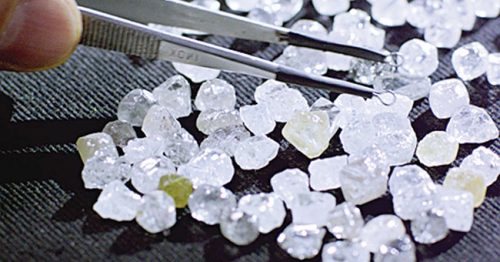Botswana Diamonds has announced that eleven diamonds and abundant kimberlitic indicators were recovered from drill samples at the recently discovered River Kimberlite pipe at Thorny River in South Africa.
John Teeling, Chairman, commented:
“The recovery of so many kimberlitic indicators and in particular diamonds, which are very rare to recover in small sample narrow reverse circulation drill holes is highly encouraging and bodes well for the potential commerciality of this exciting discovery”.
Following a detailed ground geophysical programme in October 2020, 6, six-inch percussion reverse circulation holes were drilled into the newly discovered River Kimberlite pipe.
A combined total of 39.5 m intersected kimberlite while an additional 55 m intersected a weathered kimberlite breccia.
Samples from these holes were taken at one metre intervals and twenty of these totalling about 500 kg were selected and submitted to an independent processing facility for assessment through screening, dense media separation and hand sorting.
11 Diamonds, 172 G10 pyrope garnets, 623 G9 pyrope garnets, 555 eclogitic garnets, 438 chromites and 268 chromium diopsides (clinopyroxene) were recovered at sizes between -1.0+0.3mm.
Recoveries of a specific mineral species were capped at 20 grains and thus this picture is a snapshot of the overall sample indicator content. Importantly, all the samples contained abundant kimberlitic indicators.
The diamonds are all notably of good colour and clarity and are of commercial quality and in high demand by the market. The diamonds were not weighed as the sample size was small and they are not representative of a possible population.
Pyrope garnets are common in peridotite xenoliths from kimberlite pipes, some of which are diamond-bearing. Pyrope found in association with diamond commonly has a Chromium Oxide content of three to eight percent which imparts a distinctive violet to deep purple colouration.
These are called G10 and G9 pyrope garnets. Eclogites typically result from high to ultrahigh pressure metamorphism of mafic rocks at low thermal gradients as they were subducted to the upper mantle in a subduction zone.
Garnets found in eclogitic xenoliths tend to have a deep orange colour. Diamonds in kimberlite come from both peridotitic and eclogitic xenoliths so the abundance of both types of garnet in this sample is noteworthy and this is supported by the recovery of diamonds from a relatively small drill sample.
Of significance too is that these diamonds are all of good colour and clarity. The next step is a detailed core drilling programme which is planned for the dry season.
Source: miningreview









